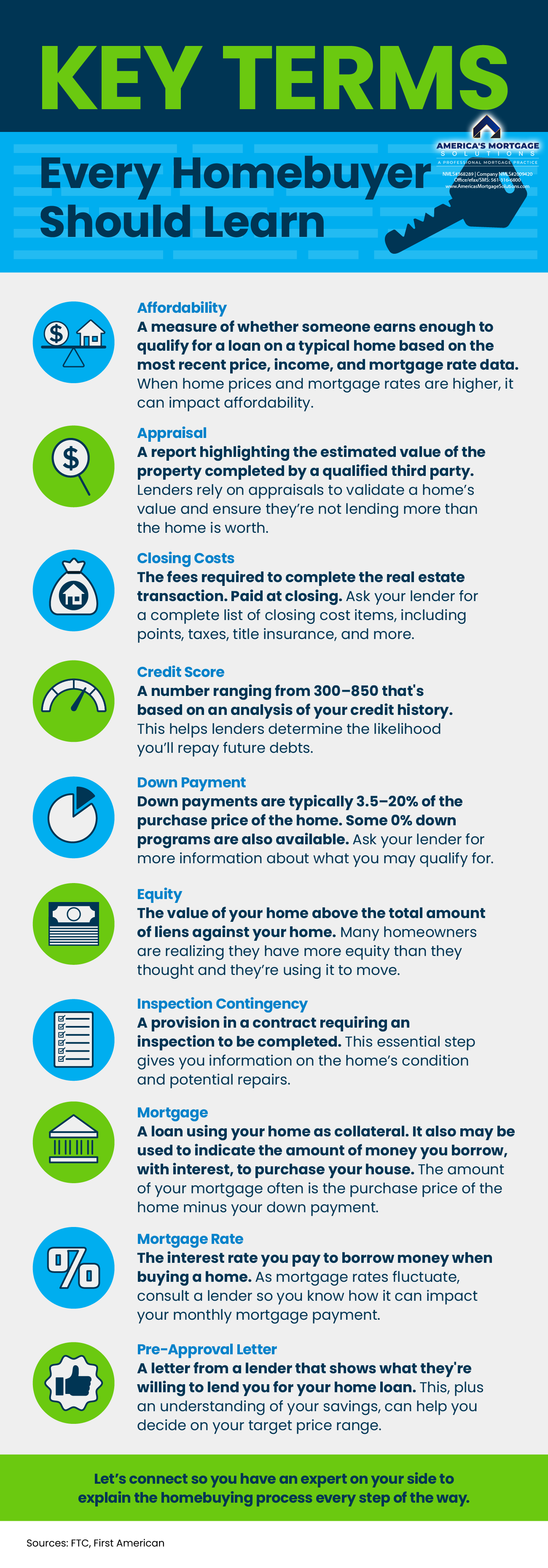
Key Terms Every Homebuyer Should Learn
Some Highlights
- Buying a home is a big deal and can feel especially complicated if you don’t know the terms used during the process.
- If you want to become a homeowner this year, it’s a good idea to learn these key housing terms and understand how they relate to the current housing market. That will help you feel confident when you buy a home.
- Let’s connect so you can get expert help with any questions you have.
Decoding the Lexicon of Homeownership: A Comprehensive Guide for Every Homebuyer
In the labyrinth of real estate, where the language can seem as complex as the market itself, it’s crucial for prospective homeowners to become fluent in the terminology that governs the process. Whether you’re on the verge of making the leap to become a homeowner or are merely contemplating the idea of buying a home, a solid grasp of key terms can empower you to navigate the currents of the current housing market with confidence.
1. The ABCs of Buying A Home
a. Appraisal:
An essential component of the homebuying process, an appraisal is a professional evaluation of a property’s value. Lenders often require this assessment to ensure that the property’s value aligns with the loan amount.
b. Escrow:
A safeguarding mechanism in real estate transactions, escrow involves a neutral third party holding funds and important documents until all conditions of the sale are met. This protects both the buyer and the seller, ensuring a smooth and fair exchange.
c. Title:
The legal document that establishes ownership of a property. A clear and marketable title is vital for a seamless transfer of ownership.
2. Cracking the Code: Buying A Home Jargon
a. Contingency:
A clause in a real estate contract that outlines specific conditions that must be met for the contract to be binding. Common contingencies include home inspections and financing approvals.
b. PITI:
This acronym encompasses the four main components of a mortgage payment: Principal, Interest, Taxes, and Insurance. Understanding the PITI breakdown is crucial for budgeting and financial planning.
c. MLS (Multiple Listing Service):
The database where real estate agents list properties for sale. Accessible to licensed professionals, the MLS is a goldmine of information for those navigating the current housing market.
3. Charting the Landscape of the Current Housing Market
a. Seller’s Market:
In a seller’s market, demand exceeds supply, giving sellers the upper hand. Homes may sell quickly, and prices tend to rise, making it a more challenging landscape for buyers.
b. Buyer’s Market:
Conversely, a buyer’s market occurs when there are more homes for sale than there are buyers. This scenario often leads to more competitive pricing and increased negotiation power for buyers.
c. Home Inspection:
A crucial step in the homebuying process, a home inspection involves a thorough examination of a property’s condition. It helps identify potential issues, allowing buyers to make informed decisions.
4. The Journey to Becoming a Homeowner
a. Amortization:
The process of paying off a loan through regular payments. Understanding amortization can shed light on the distribution of principal and interest over the life of a mortgage.
b. Down Payment:
The initial payment made by a buyer, expressed as a percentage of the total purchase price. A higher down payment often leads to lower monthly mortgage payments.
c. Closing Costs:
Additional expenses incurred at the closing table, including fees for services like appraisals, title searches, and legal assistance. Factoring in closing costs is crucial for an accurate budget.
5. The Art of Negotiation for Every Homebuyer
a. Counteroffer:
A response from the seller that modifies the original offer made by the buyer. Effective negotiation often involves a series of counteroffers until both parties reach a mutually agreeable arrangement.
b. Earnest Money:
A deposit made by the buyer to demonstrate their serious intent to purchase the property. If the sale goes through, the earnest money is typically applied to the down payment.
c. Comparable Sales (Comps):
Recent sales of similar properties used to determine a home’s fair market value. Comparable sales provide valuable insight for both buyers and sellers when setting or evaluating prices.
6. The Tapestry of Homeownership
a. Home Equity:
The portion of a property’s value owned outright by the homeowner. As mortgage payments are made, home equity increases, offering a valuable asset.
b. PMI (Private Mortgage Insurance):
A requirement for buyers with a down payment of less than 20%, PMI protects lenders in case the borrower defaults on the loan.
c. Fixed-Rate Mortgage:
A mortgage with a constant interest rate throughout its term. Opting for a fixed-rate mortgage provides stability and predictability in monthly payments.
7. Navigating the Nuances of the Homebuying Experience
a. Contested Title:
A title with unresolved issues, such as conflicting ownership claims. Recognizing and addressing a contested title is crucial to avoiding legal complications.
b. Lien:
A legal claim on a property, often used as security for a debt. Understanding liens is essential to assess a property’s financial history.
c. Deed:
The legal document conveying ownership of a property. Different types of deeds offer varying levels of protection and assurances.
8. The Culmination: From Aspiration to Becoming a Homeowner
a. Final Walkthrough:
A pre-closing inspection to ensure the property’s condition aligns with the agreed-upon terms. The final walkthrough is the last opportunity for buyers to address any concerns before sealing the deal.
b. Closing:
The final step in the homebuying process, where all necessary documents are signed, and ownership officially transfers from seller to buyer. Celebrating the closing marks the culmination of the homeowner’s journey.
c. Title Insurance:
A policy that protects the buyer and lender from potential issues with the title. Title insurance provides peace of mind, safeguarding against unforeseen challenges.
In the intricate dance of real estate, mastering these key terms is akin to acquiring a passport for your journey to homeownership. Armed with knowledge, every homebuyer can confidently navigate the twists and turns of the process, transforming the dream of buying a home into a tangible reality amidst the ebb and flow of the current housing market.
9. The Symphony of Homeownership: Ongoing Commitments
a. Homeowners Association (HOA):
For some properties, particularly in planned communities or condominiums, Homeowners Association (HOA) fees are a recurring expense. These fees contribute to communal upkeep and shared amenities, emphasizing the importance of understanding HOA regulations.
b. Property Tax:
A local government levy on the value of a property. Staying informed about property tax rates and payment schedules is crucial for maintaining financial stability as a homeowner.
c. Refinancing:
The process of replacing an existing mortgage with a new one. Refinancing can be a strategic move to secure better terms, such as a lower interest rate or reduced monthly payments.
10. Unraveling the Threads of Financial Literacy
a. Credit Score:
A numerical representation of a borrower’s creditworthiness. A higher credit score can result in more favorable mortgage terms, emphasizing the significance of responsible financial management.
b. Debt-to-Income Ratio:
A crucial metric lenders use to assess a borrower’s ability to manage monthly payments. Understanding and optimizing your debt-to-income ratio is pivotal for securing mortgage approval.
c. Amenity:
In real estate, amenities refer to desirable and attractive features of a property or its surroundings. These can range from in-house luxuries like a state-of-the-art kitchen to external factors like proximity to parks or schools.
11. The Ever-Evolving Landscape of the Current Housing Market
a. Gentrification:
The transformation of a neighborhood through the influx of higher-income residents and businesses. Gentrification can impact property values and community dynamics, influencing the desirability of certain areas.
b. Housing Bubble:
A period of rapid, unsustainable price growth followed by a sharp decline. Understanding the signs of a housing bubble is crucial for avoiding potential pitfalls in the current housing market.
c. Real Estate Agent:
A licensed professional who represents buyers or sellers in real estate transactions. Establishing a solid partnership with a knowledgeable real estate agent can significantly streamline the homebuying process.
12. Crafting Your Homeownership Narrative
a. Home Warranty:
A service contract covering the repair or replacement of major home systems and appliances. Investing in a home warranty can provide peace of mind for unexpected repairs.
b. Sweat Equity:
The investment of personal labor or effort into a property to increase its value. Embracing the concept of sweat equity can be a rewarding aspect of homeownership, particularly for those with a DIY spirit.
c. Closing Disclosure:
A comprehensive document provided to the borrower before closing, detailing the final terms and costs of the mortgage. Reviewing the closing disclosure ensures transparency and prevents last-minute surprises.
13. The Mosaic of Future Considerations
a. Home Equity Line of Credit (HELOC):
A form of revolving credit where your home serves as collateral. Understanding the dynamics of a HELOC can be valuable for leveraging your home equity for various financial goals.
b. Zoning:
Local regulations that dictate how land can be used. Familiarizing yourself with zoning laws ensures you’re aware of potential developments in your neighborhood that could impact property values.
c. Dual Agency:
When a real estate agent represents both the buyer and the seller in a transaction. Navigating the intricacies of dual agency requires careful consideration to ensure all parties’ interests are appropriately represented.
14. The Ongoing Odyssey of Homeownership
a. Home Automation:
The integration of technology to control various aspects of a home, from lighting to security systems. Home automation continues to evolve, offering homeowners increased convenience and efficiency.
b. Equity Stripping:
A practice that involves using a property’s equity to secure loans, often with the intent of leaving the property with minimal or no equity. Recognizing the risks associated with equity stripping is essential for safeguarding your investment.
c. Comparative Market Analysis (CMA):
An evaluation of similar properties in the area to determine a property’s market value. Conducting a comparative market analysis can provide valuable insights when setting or adjusting your home’s price.
In the intricate tapestry of homeownership, these additional terms weave into the ongoing narrative, capturing the essence of the ever-evolving relationship between homeowners and their properties. Embracing the continuous learning journey, from the initial dream of becoming a homeowner to the nuanced considerations of a seasoned property owner, empowers individuals to navigate the intricate real estate landscape with confidence. As you embark on this odyssey, may these terms serve as your compass, guiding you through the chapters of your unique homeownership story.
15. Sustainability in Homeownership: Environmental Footprint Matters
a. Green Building:
The practice of constructing or renovating homes with a focus on energy efficiency and environmental sustainability. Green building considerations are gaining prominence as homeowners seek to minimize their ecological impact.
b. Renewable Energy:
Sources of energy derived from naturally replenishing resources, such as sunlight or wind. Incorporating renewable energy solutions, like solar panels, can contribute to a more sustainable and cost-effective home.
c. Energy Star:
A certification indicating that appliances and products meet energy efficiency guidelines set by the Environmental Protection Agency. Opting for Energy Star rated items can reduce utility costs and promote eco-friendly living.
16. Adapting to Change: Homebuyer Resilience
a. Housing Discrimination:
Unfair treatment based on race, gender, religion, or other protected characteristics. Understanding and combatting housing discrimination is crucial for fostering inclusive and equitable communities.
b. Home Office Space:
The designated area within a home for work-related activities. The concept of a dedicated home office space has gained prominence with the rise of remote work.
c. Mortgage Forbearance:
A temporary pause or reduction in mortgage payments granted by the lender. Mortgage forbearance can be a financial lifeline during challenging times, but it’s essential to understand the long-term implications.
17. The Personalization of Home Sweet Home
a. Feng Shui:
The Chinese practice of arranging elements in a space to promote positive energy flow. Embracing the principles of Feng Shui can enhance the harmony and well-being within your home.
b. Home Decor Trends:
Ever-changing styles and preferences that influence interior design choices. Staying aware of home decor trends allows homeowners to infuse their spaces with a touch of contemporary flair.
c. Curb Appeal:
The attractiveness of a property when viewed from the street. Investing in curb appeal can increase the perceived value of your home and make a lasting impression on visitors.
18. The Guardians of Homeownership: Insurance Essentials
a. Homeowners Insurance:
A policy that provides financial protection for the structure of your home and personal belongings. Homeowners insurance is a critical safeguard against unforeseen events such as natural disasters or theft.
b. Umbrella Policy:
An additional insurance policy that extends liability coverage beyond the limits of standard policies. Considered the “extra layer” of protection, an umbrella policy is advisable for homeowners seeking comprehensive coverage.
c. Depreciation:
The reduction in the value of an asset over time. Understanding depreciation is crucial when assessing the insurance coverage needed for your home and belongings.
19. The Technological Tapestry of Homeownership
a. Smart Home Security:
Integration of technology to enhance the safety and security of a home. Smart home security systems offer features like remote monitoring and automated alerts.
b. Virtual Tour:
An online representation of a property, allowing potential buyers to explore it remotely. Virtual tours have become increasingly popular, offering a convenient way to preview homes in the digital age.
c. Home Automation Hub:
A central system that connects and controls various smart devices within a home. Home automation hubs serve as the command center for a seamless smart home experience.
20. The Culmination: A Homeowner’s Legacy
a. Property Valuation:
The process of determining the current market value of a property. Regularly assessing property valuation is essential for strategic decision-making, such as refinancing or selling.
b. Home Improvement ROI:
Return on Investment for home improvement projects. Understanding the potential ROI helps homeowners prioritize upgrades that not only enhance their living space but also contribute to the property’s overall value.
c. Home Legacy Planning:
Thoughtful consideration and planning for passing down a home to future generations. Home legacy planning involves legal and financial strategies to ensure a smooth transition of ownership.
In the grand tapestry of homeownership, these additional terms weave into the ongoing narrative, capturing the essence of the evolving relationship between homeowners and their dwellings. From sustainable living to adapting to societal changes, each term represents a thread contributing to the rich and dynamic fabric of home ownership. As you continue to traverse the realms of homeownership, may these terms serve as beacons, illuminating the path towards a fulfilling and enduring legacy within the cherished walls of your home.
In the ever-evolving lexicon of homeownership, mastering key terms is not just about linguistic proficiency but empowerment. As you embark on the journey from the dream of becoming a homeowner to the nuanced considerations of a seasoned property owner, these terms become your compass. From understanding the intricacies of the current housing market to embracing sustainable practices, each term weaves into the ongoing narrative of your unique homeownership story.
The process of buying a home is not just a transaction; it’s a journey. It involves decoding the nuances of real estate, navigating the ebbs and flows of the market, and adapting to the changing landscape of homeownership. From the initial offer to the final closing, from understanding mortgage intricacies to embracing sustainable living, each term contributes to the mosaic of knowledge that empowers you, the homeowner.
As you craft your homeownership narrative, consider these terms as tools in your toolkit, enabling you to make informed decisions, navigate challenges, and embrace the responsibilities and joys that come with owning a home. From the aesthetics of curb appeal to the pragmatics of PITI, each term plays a role in creating a harmonious and enduring connection between you and your home.
So, whether you’re a first-time homebuyer embarking on the exciting path to homeownership or a seasoned property owner looking to enhance your understanding, these terms are your companions. They transcend mere vocabulary; they are the building blocks of a fulfilling and resilient homeownership experience. As you navigate the twists and turns of the real estate landscape, may these terms illuminate your path, guiding you towards a legacy of homeownership that stands the test of time.
Read from source: “Click Me”
Questions, Comments or For more information you can call
Christian Penner Branch Manager at 561-316-6800 or email us at TheMortgageTeam@ChristianPenner.com
Approval Hotline: 561-316-6800
Helping You Achieve the American Dream of Home Ownership
Or You can click “Call Me” below to call Christian Penner directly using Google Voice
Do you know how much home you can afford?
Most people don’t... Find out in 10 minutes.
Get Pre-Approved Today

















